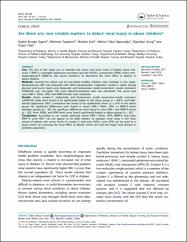| dc.contributor.author | Bostan Gayret, Özlem | |
| dc.contributor.author | Taşdemir, Mehmet | |
| dc.contributor.author | Erol, Meltem | |
| dc.contributor.author | Nacaroğlu, Hikmet Tekin | |
| dc.contributor.author | Zengi, Oğuzhan | |
| dc.contributor.author | Yiğit, Özgül | |
| dc.date.accessioned | 10.07.201910:49:13 | |
| dc.date.accessioned | 2019-07-10T20:02:50Z | |
| dc.date.available | 10.07.201910:49:13 | |
| dc.date.available | 2019-07-10T20:02:50Z | |
| dc.date.issued | 2018 | en_US |
| dc.identifier.citation | Bostan Gayret, Ö., Taşdemir, M., Erol, M., Nacaroğlu, H.,Zengi, O. ve Yiğit, Ö. (2018). Are there any new reliable markers to detect renal injury in obese children? Renal Failure, 40(1), 416-422. https://dx.doi.org/10.1080/0886022X.2018.1489284 | en_US |
| dc.identifier.issn | 0886-022X | |
| dc.identifier.issn | 1525-6049 | |
| dc.identifier.uri | https://dx.doi.org/10.1080/0886022X.2018.1489284 | |
| dc.identifier.uri | https://hdl.handle.net/20.500.12511/3745 | |
| dc.description | WOS: 000439906200001 | en_US |
| dc.description | PubMed ID: 30035656 | en_US |
| dc.description.abstract | Aim: The aim of this study was to examine the serum and urine levels of kidney injury molecule-1 (KIM-1), neutrophil gelatinase-associated lipocalin (NGAL), osteopontin (OPN), matrix metalloproteinase-9 (MMP-9), and serum Cystatin-C to determine the renal effect of obesity in obese children.Methods: Seventy-two obese and 35 non-obese healthy children were included in this study. Blood pressure (BP) was evaluated with office measurement. Creatinine, cystatin C, lipids, fasting glucose, and insulin levels were measured, and homeostasis model assessment -insulin resistance (HOMA-IR) was calculated. The urine albumin/creatinine ratio was calculated. The serum and urine KIM-1, NGAL, OPN, and MMP-9 levels were measured.Results: Serum cystatin-C, triglyceride, and homeostasis model assessment-insulin resistance (HOMA-IR) index were found to be significantly higher in the obese group (p=.0001), and high-density lipoprotein (HDL) cholesterol was found to be significantly lower (p=.019) in the obese group. No significant differences were found in serum KIM-1, NGAL, OPN or MMP-9 levels between groups (p>.05). No significant differences were found in urine KIM-1 and MMP-9 levels (p>.05), Urine NGAL, and OPN levels were found significantly higher in obese groups (p<.05).Conclusions: According to our results, although serum KIM-1, NGAL, OPN, MMP-9, and urine MMP-9, urine KIM-1 do not appear to be ideal markers to evaluate renal injury in the early period of obesity, the serum levels of cystatin C and urine NGAL, urine OPN can be used as a good marker for assessing the renal effect of obesity which can lead end stage renal disease in pediatric population. | en_US |
| dc.description.sponsorship | Bagcilar Training and Research Hospital Revolving Funds | en_US |
| dc.description.sponsorship | This research was supported by Bagcilar Training and Research Hospital Revolving Funds. | en_US |
| dc.language.iso | eng | en_US |
| dc.publisher | Taylor & Francis Ltd | en_US |
| dc.rights | info:eu-repo/semantics/openAccess | en_US |
| dc.rights | Attribution 4.0 International | * |
| dc.rights.uri | https://creativecommons.org/licenses/by/4.0/ | * |
| dc.subject | Cystatin C | en_US |
| dc.subject | KIM-1 | en_US |
| dc.subject | NGAL | en_US |
| dc.subject | OPN | en_US |
| dc.subject | MMP-9 | en_US |
| dc.subject | Obese | en_US |
| dc.subject | Children | en_US |
| dc.title | Are there any new reliable markers to detect renal injury in obese children? | en_US |
| dc.type | article | en_US |
| dc.relation.ispartof | Renal Failure | en_US |
| dc.department | İstanbul Medipol Üniversitesi, Tıp Fakültesi, Dahili Tıp Bilimleri Bölümü, Çocuk Sağlığı ve Hastalıkları Ana Bilim Dalı | en_US |
| dc.authorid | 0000-0003-1333-2648 | en_US |
| dc.identifier.volume | 40 | en_US |
| dc.identifier.issue | 1 | en_US |
| dc.identifier.startpage | 416 | en_US |
| dc.identifier.endpage | 422 | en_US |
| dc.relation.publicationcategory | Makale - Uluslararası Hakemli Dergi - Kurum Öğretim Elemanı | en_US |
| dc.identifier.doi | 10.1080/0886022X.2018.1489284 | en_US |
| dc.identifier.wosquality | Q3 | en_US |
| dc.identifier.scopusquality | Q2 | en_US |



















